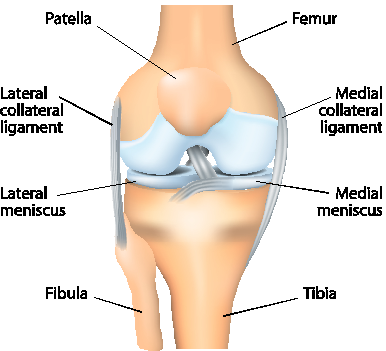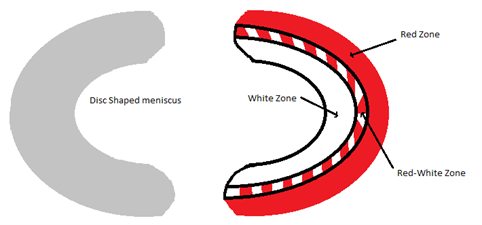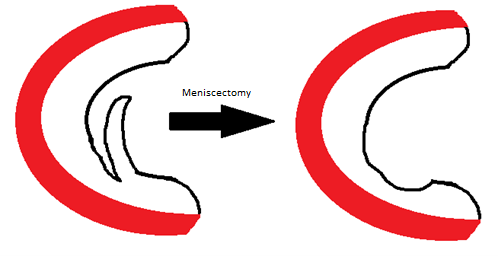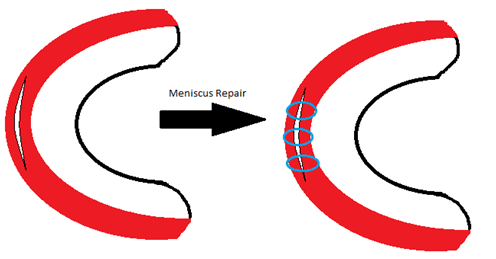
The meniscus is a disc-like structure that acts as a cushion between the femur and tibia bones in the knee. To a lesser degree, it helps with stability of the knee joint. Tears can occur in the meniscus with traumatic injuries or from regular wear and tear. The injuries usually involve a twisting mechanism, but again, many patients do not even remember a distinct injury.
The anatomy of the meniscus is very important for understanding how and why we treat the tears. The blood flow to the meniscus is very poor. Blood is what brings nutrients, growth factors and cells to the meniscus and allow it to heal. Since the meniscus has a limited blood supply, certain parts of the meniscus are more likely to heal tears and other areas can never heal. This is similar to a finger nail, hair and teeth; all of which have a vascular and a non-vascular component. The vascular portion is called the “red zone” due to the presence of capillaries in the meniscal tissue. The avascular portion is called the “white zone” due to its absence of blood supply. Red zone tears have the potential to heal and white zone tears will likely never heal. The transitional region in the middle is considered the “red-white zone.”

Patients with a meniscus tear can have swelling in the knee, clicking in the knee, pain with twisting and often can isolate their pain to one region on either the inside (medial) knee or outside (lateral) knee.
The diagnosis of a meniscus tear is usually made on physical exam and confirmed using an MRI. During the workup, an x ray of the knee is usually obtained to evaluate for findings of osteoarthritis. If osteoarthritis is present, it is still possible to have a meniscus tear but it can change the way in which it is treated.
The treatment for a meniscus tear is dependent on the type of tear. Meniscus tears can be divided into three main groups:
- White zone tears (Central tears)
- Red zone tears (Peripheral tears)
- Tears associated with degenerative arthritis
White zone tears
Due to their lack of blood supply, these tears have a very unlikely chance of healing. For this reason, they often require surgery. The loose fragments will often flip around in the joint and can become caught which will cause sudden sharp pain. There is limited role for nonsurgical treatment for these tears since they tend to be painful and have a low probability of healing. During the surgical procedure, an arthroscopic minimally invasive camera is inserted into the joint and through another tiny incision, tools are used to excise the loose fragments. The meniscus is very important to protecting the cartilage of the knee and prevent arthritis, so great care is taken to only remove the loose, damaged, nonfunctional meniscus fragments and leave the healthy portion. The procedure is usually uncomplicated and a relatively quick recovery. The technical name of the procedure is a “meniscectomy.”

Red zone tears
Due to the presence of blood supply, these tears have the potential to heal. If the MRI demonstrates a tear in this zone, it is possible to treat it without surgery at first. Depending on the duration of the tear and the size of the tear, non-surgical treatment is an option if the patient is able to effectively rest the knee to allow for healing to occur. If the tear is large, displaced or has failed to heal on its own then a surgical repair should be performed. Similar to the meniscectomy procedure, meniscal repairs are also accomplished through a small surgical procedure using an arthroscopic camera. After inserting a camera through one incision, small tools are inserted through the other incision in order to place small sutures into the meniscus. This procedure allows the patient to retain their meniscus instead of removing it. The ultimate decision to repair versus remove meniscus is made during surgery when the exact location and type of tear can be identified. As opposed to the meniscectomy, following a meniscal repair, restrictions are often placed on the patient to give the tear the best chance of healing. These restrictions can often slow athletes return to sports. If a repair is possible, this is the preferential treatment as it may help to prevent arthritis compared to a meniscectomy. Unfortunately, not all tears are amenable to a repair.


Tears associated with degenerative arthritis
Knee arthritis is a condition that causes progressive degeneration of the structures of the knee. As it progresses, the cartilage wears away, the meniscus tears, ligaments may tear and eventually the bone itself will deteriorate. It is important to understand that these meniscus tears are not isolated meniscal tears, but part of the degenerative process. For this reason, these tears tend to be treated non-surgically. Arthroscopic surgery often does not resolve the patient’s pain and has a very limited role. There is a small sub-group of people that can benefit from an arthroscopic procedure, but in general, these patients are treated for the true condition for which they suffer, arthritis.
